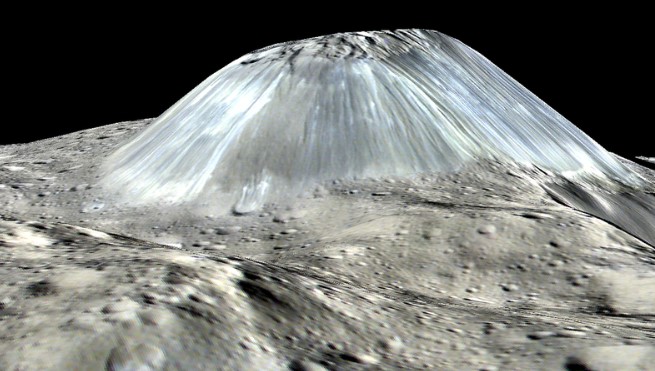
AHUNA MONS IS A LARGE, large volcano. Its base is 12 miles across; its peak rises three miles from the surrounding landscape. But that doesn’t mean that it is capable of similarly big eruptions. When it last blew, sometime in the last 240 million years, it didn’t explode so much as ooze.
Ahuna Mons is what is known as a cryovolcano, and sits on Ceres, the dwarf planet that’s the largest object in the asteroid belt between Mars and Jupiter. Its eruptions never produced plumes of ash or streams of lava, but rather an icy excretion made of gases such as ammonia, water, and methane. When exposed to the cold expanse of space, the mixture flash freezes to form a kind of carapace, while the interior remains stay liquid and gas escapes or leaks through fractures.
Ahuna Mons was first identified in 2015 by NASA’s Dawn mission. At the time, it was the only known volcano—ice or otherwise—on Ceres. In a new paper published in Nature Astronomy, researchers argue that it’s not alone.
A team led by Michael Sori, of the Lunar and Planetary Laboratory of the University of Arizona, studied topographic maps captured by Dawn, and found 32 large domes measuring more than 6.2 miles in diameter, which were deemed large enough to be potential volcanoes. Ten of them were left out of the analysis because impact craters made them hard to measure reliably. (Such is life in an asteroid belt!) The remaining 22 mounds, though, are likely to be cryovolcanoes, many of them long-dormant and somewhat collapsed into the flatter landscape around them.
The researchers suggest that these volcanoes have been erupting for more than a billion years, and some of them may be repeat erupters. The asymmetry and fractures on Ahuna Mons, for instance, are “consistent with multiple episodes, rather than the whole mountain being built in one go,” Sori says.
On Earth, volcanic activity often generates new land, but not on Ceres. The researchers estimate that the icy eruptions have spewed 100,000 times less volume across Ceres than the hotter eruptions on Earth.
Researchers aren’t sure what, exactly, causes this phenomenon, or whether similar eruptions are happening on other asteroids or planetary bodies, such as moons. On Ceres, “we’ve never seen these eruptions happen in real time,” Sori says. “There’s no substitute for seeing things happen in real time, but we can speculate intelligently based on our knowledge of regular lava flows.” There’s much more to learn about what cryovolcanoes are and how they behave. But we’re sure they’re like nothing on Earth.